Now it is quite a long time (almost two months) that I was working on FCN32 for semantic segmentation of single channel images. I played around with different learning rates and even adding BatchNormalization layer. However, I was not successful to even see any output. I did not have any choice except to instantly ask for help here. I really do not know what I am doing wrong.
I am sending one image to the network as a batch.This the train-loss curve LR=1e-9 and lr_policy="fixed":

I increased the learning rate to 1e-4(the following figure). It seems that loss is falling down, however, the learning curve is not acting normal.

I reduced the layers of original FCN as follows: (1) Conv64 – ReLU – Conv64 – ReLU – MaxPool
(2) Conv128 – ReLU – Conv128 – ReLU – MaxPool
(3) Conv256 – ReLU – Conv256 – ReLU – MaxPool
(4) Conv4096 – ReLU – Dropout0.5
(5) Conv4096 – ReLU – Dropout0.5
(6) Conv2
(7) Deconv32x – Crop
(8) SoftmaxWithLoss
layer {
name: "data"
type: "Data"
top: "data"
include {
phase: TRAIN
}
transform_param {
mean_file: "/jjj/FCN32_mean.binaryproto"
}
data_param {
source: "/jjj/train_lmdb/"
batch_size: 1
backend: LMDB
}
}
layer {
name: "label"
type: "Data"
top: "label"
include {
phase: TRAIN
}
data_param {
source: "/jjj/train_label_lmdb/"
batch_size: 1
backend: LMDB
}
}
layer {
name: "data"
type: "Data"
top: "data"
include {
phase: TEST
}
transform_param {
mean_file: "/jjj/FCN32_mean.binaryproto"
}
data_param {
source: "/jjj/val_lmdb/"
batch_size: 1
backend: LMDB
}
}
layer {
name: "label"
type: "Data"
top: "label"
include {
phase: TEST
}
data_param {
source: "/jjj/val_label_lmdb/"
batch_size: 1
backend: LMDB
}
}
layer {
name: "conv1_1"
type: "Convolution"
bottom: "data"
top: "conv1_1"
param {
lr_mult: 1
decay_mult: 1
}
param {
lr_mult: 2
decay_mult: 0
}
convolution_param {
num_output: 64
pad: 100
kernel_size: 3
stride: 1
}
}
layer {
name: "relu1_1"
type: "ReLU"
bottom: "conv1_1"
top: "conv1_1"
}
layer {
name: "conv1_2"
type: "Convolution"
bottom: "conv1_1"
top: "conv1_2"
param {
lr_mult: 1
decay_mult: 1
}
param {
lr_mult: 2
decay_mult: 0
}
convolution_param {
num_output: 64
pad: 1
kernel_size: 3
stride: 1
}
}
layer {
name: "relu1_2"
type: "ReLU"
bottom: "conv1_2"
top: "conv1_2"
}
layer {
name: "pool1"
type: "Pooling"
bottom: "conv1_2"
top: "pool1"
pooling_param {
pool: MAX
kernel_size: 2
stride: 2
}
}
layer {
name: "conv2_1"
type: "Convolution"
bottom: "pool1"
top: "conv2_1"
param {
lr_mult: 1
decay_mult: 1
}
param {
lr_mult: 2
decay_mult: 0
}
convolution_param {
num_output: 128
pad: 1
kernel_size: 3
stride: 1
}
}
layer {
name: "relu2_1"
type: "ReLU"
bottom: "conv2_1"
top: "conv2_1"
}
layer {
name: "conv2_2"
type: "Convolution"
bottom: "conv2_1"
top: "conv2_2"
param {
lr_mult: 1
decay_mult: 1
}
param {
lr_mult: 2
decay_mult: 0
}
convolution_param {
num_output: 128
pad: 1
kernel_size: 3
stride: 1
}
}
layer {
name: "relu2_2"
type: "ReLU"
bottom: "conv2_2"
top: "conv2_2"
}
layer {
name: "pool2"
type: "Pooling"
bottom: "conv2_2"
top: "pool2"
pooling_param {
pool: MAX
kernel_size: 2
stride: 2
}
}
layer {
name: "conv3_1"
type: "Convolution"
bottom: "pool2"
top: "conv3_1"
param {
lr_mult: 1
decay_mult: 1
}
param {
lr_mult: 2
decay_mult: 0
}
convolution_param {
num_output: 256
pad: 1
kernel_size: 3
stride: 1
}
}
layer {
name: "relu3_1"
type: "ReLU"
bottom: "conv3_1"
top: "conv3_1"
}
layer {
name: "conv3_2"
type: "Convolution"
bottom: "conv3_1"
top: "conv3_2"
param {
lr_mult: 1
decay_mult: 1
}
param {
lr_mult: 2
decay_mult: 0
}
convolution_param {
num_output: 256
pad: 1
kernel_size: 3
stride: 1
}
}
layer {
name: "relu3_2"
type: "ReLU"
bottom: "conv3_2"
top: "conv3_2"
}
layer {
name: "pool3"
type: "Pooling"
bottom: "conv3_2"
top: "pool3"
pooling_param {
pool: MAX
kernel_size: 2
stride: 2
}
}
layer {
name: "fc6"
type: "Convolution"
bottom: "pool3"
top: "fc6"
param {
lr_mult: 1
decay_mult: 1
}
param {
lr_mult: 2
decay_mult: 0
}
convolution_param {
num_output: 4096
pad: 0
kernel_size: 7
stride: 1
}
}
layer {
name: "relu6"
type: "ReLU"
bottom: "fc6"
top: "fc6"
}
layer {
name: "drop6"
type: "Dropout"
bottom: "fc6"
top: "fc6"
dropout_param {
dropout_ratio: 0.5
}
}
layer {
name: "fc7"
type: "Convolution"
bottom: "fc6"
top: "fc7"
param {
lr_mult: 1
decay_mult: 1
}
param {
lr_mult: 2
decay_mult: 0
}
convolution_param {
num_output: 4096
pad: 0
kernel_size: 1
stride: 1
}
}
layer {
name: "relu7"
type: "ReLU"
bottom: "fc7"
top: "fc7"
}
layer {
name: "drop7"
type: "Dropout"
bottom: "fc7"
top: "fc7"
dropout_param {
dropout_ratio: 0.5
}
}
layer {
name: "score_fr"
type: "Convolution"
bottom: "fc7"
top: "score_fr"
param {
lr_mult: 1
decay_mult: 1
}
param {
lr_mult: 2
decay_mult: 0
}
convolution_param {
num_output: 5 #21
pad: 0
kernel_size: 1
weight_filler {
type: "xavier"
}
bias_filler {
type: "constant"
}
}
}
layer {
name: "upscore"
type: "Deconvolution"
bottom: "score_fr"
top: "upscore"
param {
lr_mult: 0
}
convolution_param {
num_output: 5 #21
bias_term: false
kernel_size: 64
stride: 32
group: 5 #2
weight_filler: {
type: "bilinear"
}
}
}
layer {
name: "score"
type: "Crop"
bottom: "upscore"
bottom: "data"
top: "score"
crop_param {
axis: 2
offset: 19
}
}
layer {
name: "accuracy"
type: "Accuracy"
bottom: "score"
bottom: "label"
top: "accuracy"
include {
phase: TRAIN
}
}
layer {
name: "accuracy"
type: "Accuracy"
bottom: "score"
bottom: "label"
top: "accuracy"
include {
phase: TEST
}
}
layer {
name: "loss"
type: "SoftmaxWithLoss"
bottom: "score"
bottom: "label"
top: "loss"
loss_param {
ignore_label: 255
normalize: true
}
}
and this is the solver definition:
net: "train_val.prototxt"
#test_net: "val.prototxt"
test_iter: 736
# make test net, but don't invoke it from the solver itself
test_interval: 2000 #1000000
display: 50
average_loss: 50
lr_policy: "step" #"fixed"
stepsize: 2000 #+
gamma: 0.1 #+
# lr for unnormalized softmax
base_lr: 0.0001
# high momentum
momentum: 0.99
# no gradient accumulation
iter_size: 1
max_iter: 10000
weight_decay: 0.0005
snapshot: 2000
snapshot_prefix: "snapshot/NET1"
test_initialization: false
solver_mode: GPU
At the beginning, the loss is starting to fall down, but again after some iterations, it is not showing good learning behavior:

I am a beginner in deep learning and caffe. I really do not understand why this happens. I really appreciate if those that have expertise, please have a look on the model definition and I will be very thankful if you help me.